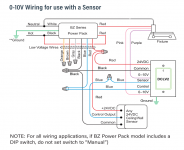Alwayslearningelec
Senior Member
- Location
- NJ
- Occupation
- Estimator
Pretty basic setup here.
Occupancy sensor is 24v .
Fixture has 0-10v integral dimming driver.
Don’t know exact wall switch type but obviously has to be dimmer.
Just not 100% certain on few wiring things.
1. I would need to have both power & 0-10v from fixture to the power pack?
2. Wire from dimmer switch would be what and ran to where? I believe I go from switch to power pack with line voltage but then I need to bring 0-10v wires from switch to side of power pack where I have the wires from the fixture and splice. Correct?

Occupancy sensor is 24v .
Fixture has 0-10v integral dimming driver.
Don’t know exact wall switch type but obviously has to be dimmer.
Just not 100% certain on few wiring things.
1. I would need to have both power & 0-10v from fixture to the power pack?
2. Wire from dimmer switch would be what and ran to where? I believe I go from switch to power pack with line voltage but then I need to bring 0-10v wires from switch to side of power pack where I have the wires from the fixture and splice. Correct?



